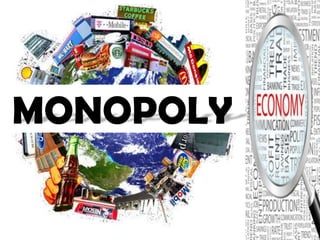
MONOPOLY
- 1. MONOPOLY
- 2. Monopoly - Refers to the form of market organization in which there is a single seller of a product without close substitute. - Characterized by an absence of competition, which often results in high prices and inferior products. Pure monopoly - Exists when a single firm is the sole producer of a product or services for which there are no close substitutes. Monopoly is virtually not-existent in basic manufacturing industries but was fairly common tobacco and other areas. It occurs most commonly in regulated public utilities where transportation costs allow seller to act as a monopolist within a certain range of prices.
- 3. Examples:
- 4. Characteristics of Monopoly 1. 2. 3. Monopolies can maintain super-normal profits in the long run. With no close substitutes, the monopolist can derive super-normal profits A monopolist with no substitutes would be able to derive the greatest monopoly power. The advantages of monopolies Avoid the wasteful duplication of infrastructure that would happen if new firms were encouraged to build their own infrastructure. Domestic monopolies can become dominant in their own territory and then penetrate overseas markets, earning a country valuable export revenues. The disadvantages of monopoly to the consumer Restricting output onto the market. Charging a higher price than in a more competitive market. Reducing consumers surplus and economic welfare. Restricting choice for consumers. Reducing consumer sovereignty.
- 5. Common Misconceptions about Monopoly Highest Price People often believe that monopolists will try to get highest possible price for their goods and services, because they can manipulate price, but this statement isn’t correct. There are some prices for which monopolists will get smaller-than-maximum profit, so they will try to avoid them. Monopolists are trying to get maximum total profit, but not maximum price. Some High prices will reduce dramatically quantity sold and total revenue, so that monopolists will try to produce a decrease in cost. Profit Monopolists seek maximum total product, not maximum unit profit. They will choose smaller unit profit, not the maximum one, because additional sales add to total revenue.
- 6. Losses Monopolists are more likely to get economic profit than pure competitor. In long run pure competitor is destined to get only normal profit, but price adjustment ability and barriers at entry at monopolists offer them possibility to get economic profit. But pure monopoly doesn’t always guarantee profit. It is neither immune to change in taste of consumers that reduces demand for the product nor to change in price of resources. So an industry can suffer great losses because of relatively low demand and high resource prices. Like pure competitors, monopolists won’t continue to operate in an industry where they get continued losses. So if they are faced with this situation, pure monopolists may move their resources to alternative uses that offer better opportunities for economic profit. Thus, monopolies can also realize normal profit in long run.
- 7. Price Discrimination This occurs when a firm charges a different price to different groups of consumers for an identical good or service, for reasons not associated with the costs of production. It is important to stress that charging different prices for similar goods is not price discrimination. 3 basic conditions required for price discrimination to work: • Monopoly power Firms must have some price setting power - so we don't see price discrimination in perfectly competitive markets. • Elasticity of demand There must be a different price elasticity of demand for the product from each group of consumers. This allows the firm to extract consumer surplus by varying the price leading to additional revenue and profit. • Separation of the market The firm must be able to split the market into different sub-groups of consumers and then prevent the good or service being resold between consumers must not be prohibitive.
- 8. Examples of price discrimination: There are numerous good examples of discriminatory pricing policies. We must be careful to distinguish between discrimination (based on consumer's willingness to pay) and product differentiation - where price differences might also reflect a different quality or standard of service. Some examples worth considering include: Cinemas and theatres cutting prices to attract younger and older audiences Student discounts for rail travel, restaurant meals and holidays Car rental firms cutting prices at weekends Hotels offering cheap weekend breaks and winter discounts
- 9. Regulation of Monopoly Public welfare dictates the government should take more active role in the regulation of monopolies. Monopolies cannot just be left alone by the government in the same way as other industries in more competitive models are left alone. 2 parties involved: - Monopolist who tends to maximize profit - consumers who must be protected by government and give fair deal by monopolist.
- 10. Monopolies in the Philippine Setting There is nothing wrong with monopolies, especially in public utilities like power, water, telecommunications and the like, provided management and those who work for such enterprises remember what their real role in the economy is and why they are granted exclusive franchise in their areas of operations.
